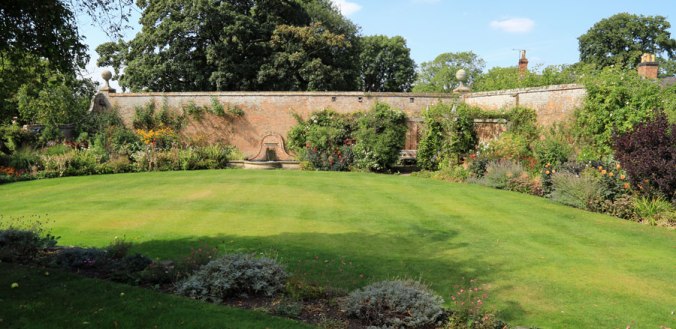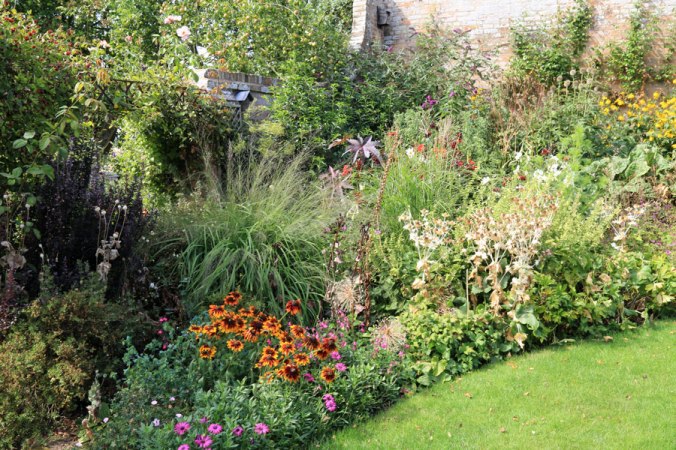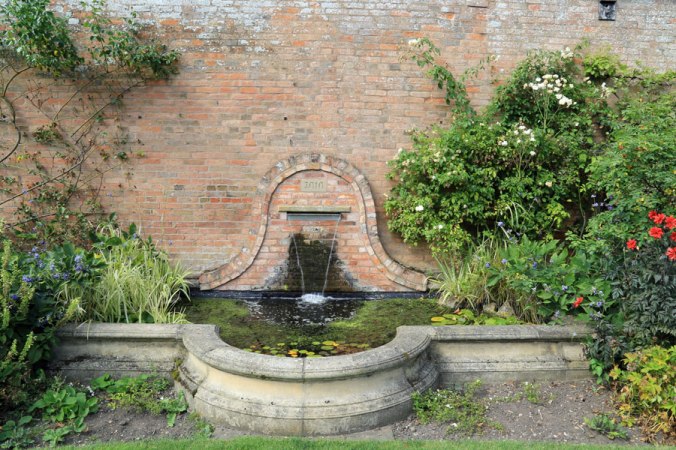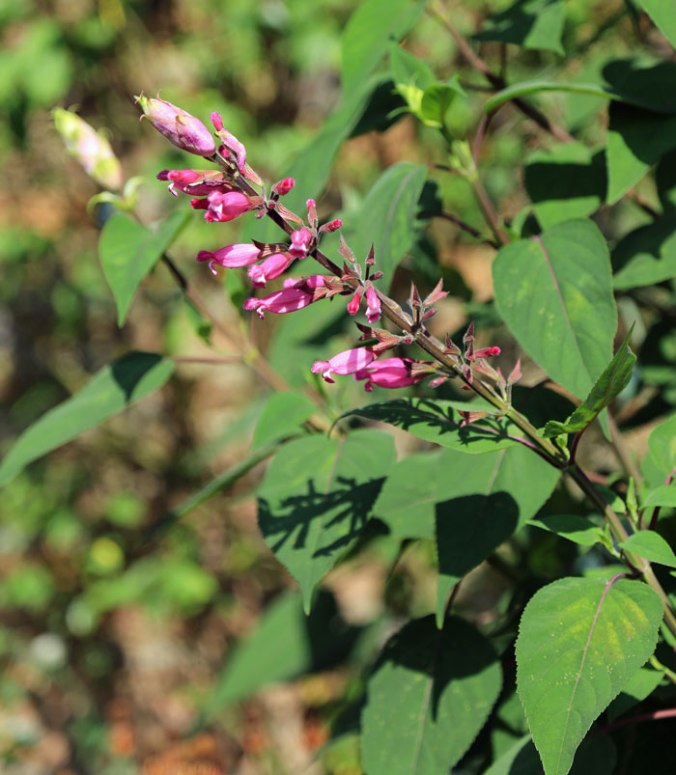It is always amazing that it is possible to live in a relatively small country and have not visited all the various parts of that country. It was for this reason we decided to have a short holiday in Suffolk, a location that would also enable us to visit Beth Chatto’s garden and explore the Suffolk county.
Ickworth House
First stop of interest was the National Trust property Ickworth House.  Ickworth house is dominated by the impressive Rotunda commissioned by the 4th Earl of Bristol to house his priceless treasures collected on tours around Europe in the 18th-century. For 200 years, the eccentric, and sometimes infamous, Hervey family added to the treasures inside and out, also creating the earliest Italianate garden in England. The Italianate garden was interesting but not very photographic. It is essentially an evergreen garden with miles of box hedging. Sadly much of the hedging is suffering from box blight and, as a result, now looks very neglected. Interestingly the balls in the picture above were not box but nevertheless look very effective.
Ickworth house is dominated by the impressive Rotunda commissioned by the 4th Earl of Bristol to house his priceless treasures collected on tours around Europe in the 18th-century. For 200 years, the eccentric, and sometimes infamous, Hervey family added to the treasures inside and out, also creating the earliest Italianate garden in England. The Italianate garden was interesting but not very photographic. It is essentially an evergreen garden with miles of box hedging. Sadly much of the hedging is suffering from box blight and, as a result, now looks very neglected. Interestingly the balls in the picture above were not box but nevertheless look very effective.
The grounds of the estate offer a number of walks in a very “Capability Brown” landscape although there is no evidence that he actually did any work on the gardens.  The kitchen gardens are huge and as is often the case have mostly become grass and weeds. However, there are plans to renovate them which will give an extra point of interest for garden enthusiasts.
The kitchen gardens are huge and as is often the case have mostly become grass and weeds. However, there are plans to renovate them which will give an extra point of interest for garden enthusiasts.  However, there is much work to be done!
However, there is much work to be done!
Lavenham
 Suffolk is well endowed with beautiful medieval villages and Lavenham is one of the best. Apparently the reason there are so many medieval buildings is that the town had been very prosperous. By the middle of the 15th century Lavenham was one of the most significant weaving centres in England, and remarkably for a town that never had a population greater than 2000, it is said to have been the 14th richest settlement in the country. However, this did not last and it went into rapid decline. This relative poverty helped preserve the place in its medieval glory for us to admire, as the residents could not afford to improve their properties. As a consequence many medieval houses still exist. There is a guided walk which describes many of the medieval buildings and is well worth doing if you visit Lavenham.
Suffolk is well endowed with beautiful medieval villages and Lavenham is one of the best. Apparently the reason there are so many medieval buildings is that the town had been very prosperous. By the middle of the 15th century Lavenham was one of the most significant weaving centres in England, and remarkably for a town that never had a population greater than 2000, it is said to have been the 14th richest settlement in the country. However, this did not last and it went into rapid decline. This relative poverty helped preserve the place in its medieval glory for us to admire, as the residents could not afford to improve their properties. As a consequence many medieval houses still exist. There is a guided walk which describes many of the medieval buildings and is well worth doing if you visit Lavenham.

The Guildhall

No 55 Water Street
 Numbers 10 and 11 Lady Street, now a very nice bistro. And there are many more similar properties.
Numbers 10 and 11 Lady Street, now a very nice bistro. And there are many more similar properties.
Beth Chatto’s garden
For many years I have read articles by Beth Chatto and have always wanted to visit her garden.  The gardens started in 1960 when she took an overgrown wasteland of brambles, parched gravel and boggy ditches, transforming it using plants adapted by nature to thrive in different conditions to create the garden we see today. What was once a car park is now the much publicised Gravel Garden (which is never watered).
The gardens started in 1960 when she took an overgrown wasteland of brambles, parched gravel and boggy ditches, transforming it using plants adapted by nature to thrive in different conditions to create the garden we see today. What was once a car park is now the much publicised Gravel Garden (which is never watered).
The garden is as you would expect very well maintained and some of the vistas are very attractive however, for me, the gardens lacked the ultimate wow factor. I would also have liked to have seen more plant labelling which I would have expected given the garden’s heritage.
The Gravel Garden was a little disappointing particularly given Beth Chatto’s writings on plants for dry places. There were plenty of plants surviving the dry conditions but they did not work as a whole. This may have been that we were seeing the garden after a long very hot period.
Hyde Hall
Our next garden visit was the Royal Horticultural Gardens at Hyde Hall. The RHS took over the land in 1993 and have been developing the gardens since then. It is 10 years since we last visited Hyde Hall and the developments and maturity of the gardens since then have been significant.

Modern Country show garden
Grasses are used to good effect throughout the garden. One of the colour coded borders which were looking fantastic for the middle of september.
One of the colour coded borders which were looking fantastic for the middle of september.
The Dry Garden, above, was one of the first developments when the RHS started to develop the garden. They are really very interesting with a huge range of plants and are a star attraction in the garden. A new development for 2017. The hard landscaping for a new vegetable area which will be based around a circle divided into quarters, each representing a different area of the world. Other developments include the landscaping and planting of the acres of land and the planting of a winter garden.
A new development for 2017. The hard landscaping for a new vegetable area which will be based around a circle divided into quarters, each representing a different area of the world. Other developments include the landscaping and planting of the acres of land and the planting of a winter garden.  Lastly it is always nice to take home some new planting ideas such as this Rudbeckia.
Lastly it is always nice to take home some new planting ideas such as this Rudbeckia.
Glebe House Garden
The garden had to look after itself this week!
| Gardening Hours |
| This week |
Total since June 19th |
Average per week |
| 6 |
201 |
17 |
 This is the same view across the garden that I took in August. Actually I am surprised to see that there are now more flowers on show. Looking at some of these stars we have:
This is the same view across the garden that I took in August. Actually I am surprised to see that there are now more flowers on show. Looking at some of these stars we have: Osteospermum ‘Tresco Purple’ which is new in the garden this year although I have often seen it in Tresco. It has done really well and forms a low bushy plant which is claimed to be hardy. However as with all our osteospermums we take cutting which will remain in the greenhouse till next spring.
Osteospermum ‘Tresco Purple’ which is new in the garden this year although I have often seen it in Tresco. It has done really well and forms a low bushy plant which is claimed to be hardy. However as with all our osteospermums we take cutting which will remain in the greenhouse till next spring.
 Rudbeckia ‘Herbstone’ makes a huge plant at the back of the border. The main issue is supporting it from falling onto the other plants.
Rudbeckia ‘Herbstone’ makes a huge plant at the back of the border. The main issue is supporting it from falling onto the other plants. Roses are continuing to flower with the very warm weather we have been having. This is Rosa Awakening a climber on the wall.
Roses are continuing to flower with the very warm weather we have been having. This is Rosa Awakening a climber on the wall. Cosmos bipinnatus ‘Purity’ has grown and grown with some plants over six feet high which usually mean they have collapsed onto other plants.
Cosmos bipinnatus ‘Purity’ has grown and grown with some plants over six feet high which usually mean they have collapsed onto other plants. Apples, apples and more apples. This is a very old tree of unknown stock but they do keep quite well for upto six months. We will pick some for storage soon.
Apples, apples and more apples. This is a very old tree of unknown stock but they do keep quite well for upto six months. We will pick some for storage soon. Salvia ‘Cerro Potosi’ a useful hardy salvia. We cut it back each spring and it grows and grows!
Salvia ‘Cerro Potosi’ a useful hardy salvia. We cut it back each spring and it grows and grows! and at the back is this aster. It is one of the few plants that was in the garden when we moved here in 1994. It is very tall (about six feet) and very reliable but I do not know exactly what variety it is. Could be Aster praealtus any other suggestions?
and at the back is this aster. It is one of the few plants that was in the garden when we moved here in 1994. It is very tall (about six feet) and very reliable but I do not know exactly what variety it is. Could be Aster praealtus any other suggestions?








 There are a number of yew hedges in the garden. This is looking along the area behind the garden wall and when we originally moved in this area was effectively a small paddock. As it ran south west to north west when we had any degree of wind it certainly blow up this side of the wall. We put the yew hedges in to provide some shelter for any planting we did. Over the years they have grown into substantial hedges but of course they need cutting although only once a year.
There are a number of yew hedges in the garden. This is looking along the area behind the garden wall and when we originally moved in this area was effectively a small paddock. As it ran south west to north west when we had any degree of wind it certainly blow up this side of the wall. We put the yew hedges in to provide some shelter for any planting we did. Over the years they have grown into substantial hedges but of course they need cutting although only once a year.

 Quite a difficult area as it gets little sun and on the right, in our neighbour’s garden, is a large sycamore tree creating even more shade. The wall is also about 14 feet high! Let me know if you have any good ideas.
Quite a difficult area as it gets little sun and on the right, in our neighbour’s garden, is a large sycamore tree creating even more shade. The wall is also about 14 feet high! Let me know if you have any good ideas. Another hedge that needs cutting each year is a beech hedge with some hornbeam Carpinus betulus ‘Frans Fontaine columns. What is always amazing is the amount of growth that can occur in one year as shown above with the hedge cutting half complete.
Another hedge that needs cutting each year is a beech hedge with some hornbeam Carpinus betulus ‘Frans Fontaine columns. What is always amazing is the amount of growth that can occur in one year as shown above with the hedge cutting half complete. The completed cut.
The completed cut. and another to my surprise a Great Crested Newt.
and another to my surprise a Great Crested Newt.


 Ickworth house is dominated by the impressive Rotunda commissioned by the 4th Earl of Bristol to house his priceless treasures collected on tours around Europe in the 18th-century. For 200 years, the eccentric, and sometimes infamous, Hervey family added to the treasures inside and out, also creating the earliest Italianate garden in England. The Italianate garden was interesting but not very photographic. It is essentially an evergreen garden with miles of box hedging. Sadly much of the hedging is suffering from box blight and, as a result, now looks very neglected. Interestingly the balls in the picture above were not box but nevertheless look very effective.
Ickworth house is dominated by the impressive Rotunda commissioned by the 4th Earl of Bristol to house his priceless treasures collected on tours around Europe in the 18th-century. For 200 years, the eccentric, and sometimes infamous, Hervey family added to the treasures inside and out, also creating the earliest Italianate garden in England. The Italianate garden was interesting but not very photographic. It is essentially an evergreen garden with miles of box hedging. Sadly much of the hedging is suffering from box blight and, as a result, now looks very neglected. Interestingly the balls in the picture above were not box but nevertheless look very effective. The kitchen gardens are huge and as is often the case have mostly become grass and weeds. However, there are plans to renovate them which will give an extra point of interest for garden enthusiasts.
The kitchen gardens are huge and as is often the case have mostly become grass and weeds. However, there are plans to renovate them which will give an extra point of interest for garden enthusiasts.  However, there is much work to be done!
However, there is much work to be done! Suffolk is well endowed with beautiful medieval villages and
Suffolk is well endowed with beautiful medieval villages and 

 Numbers 10 and 11 Lady Street, now a very nice bistro. And there are many more similar properties.
Numbers 10 and 11 Lady Street, now a very nice bistro. And there are many more similar properties. The gardens started in 1960 when she took an overgrown wasteland of brambles, parched gravel and boggy ditches, transforming it using plants adapted by nature to thrive in different conditions to create the garden we see today. What was once a car park is now the much publicised Gravel Garden (which is never watered).
The gardens started in 1960 when she took an overgrown wasteland of brambles, parched gravel and boggy ditches, transforming it using plants adapted by nature to thrive in different conditions to create the garden we see today. What was once a car park is now the much publicised Gravel Garden (which is never watered).








 One of the colour coded borders which were looking fantastic for the middle of september.
One of the colour coded borders which were looking fantastic for the middle of september.




 A new development for 2017. The hard landscaping for a new vegetable area which will be based around a circle divided into quarters, each representing a different area of the world. Other developments include the landscaping and planting of the acres of land and the planting of a winter garden.
A new development for 2017. The hard landscaping for a new vegetable area which will be based around a circle divided into quarters, each representing a different area of the world. Other developments include the landscaping and planting of the acres of land and the planting of a winter garden.  Lastly it is always nice to take home some new planting ideas such as this Rudbeckia.
Lastly it is always nice to take home some new planting ideas such as this Rudbeckia. Bags of shredding waiting to be added with a pile of composted compost that will be used as mulch later this year. As you can see the compost area is also a general storage area with some logs from a local farmer and some pots of gravel.
Bags of shredding waiting to be added with a pile of composted compost that will be used as mulch later this year. As you can see the compost area is also a general storage area with some logs from a local farmer and some pots of gravel. The compost bins have been renewed this year after the previous ones rotted away after having given service for twenty three years. The bins are constructed with marine plywood sides with planks that slot into the front to give access for emptying and also filling.
The compost bins have been renewed this year after the previous ones rotted away after having given service for twenty three years. The bins are constructed with marine plywood sides with planks that slot into the front to give access for emptying and also filling. We basically have three such bins. There are holes in the plywood to let animals into the heap and also for some aeration of the heap. The two bins on the right are used to receive materials from the garden, the bin on the left is used when we need to turn the heap in one of the two right hand bins. We find that turning the heap speeds up the compost process and gives a much better final result. The only downside is it is very hard work turning the heap!
We basically have three such bins. There are holes in the plywood to let animals into the heap and also for some aeration of the heap. The two bins on the right are used to receive materials from the garden, the bin on the left is used when we need to turn the heap in one of the two right hand bins. We find that turning the heap speeds up the compost process and gives a much better final result. The only downside is it is very hard work turning the heap! The left hand bin just after we have turned the compost from the centre bin. (plus a few leaves from the trees under which the bins are located).
The left hand bin just after we have turned the compost from the centre bin. (plus a few leaves from the trees under which the bins are located). The compost ready for mulching.
The compost ready for mulching. They are not dangerous but the thought of me standing in the compost heap with a snake trying to make a quick exit up my trouser legs beggars belief. I shall have to remember to tuck my trousers into my socks next time I turn the heap!
They are not dangerous but the thought of me standing in the compost heap with a snake trying to make a quick exit up my trouser legs beggars belief. I shall have to remember to tuck my trousers into my socks next time I turn the heap! This is a view across the garden into what was originally a walled kitchen garden to the village rectory. The wall at the back is double skinned and could be heated via a fireplace and a system of brick ducts to transport the heat through the wall. The flower beds were originally only a couple of feet deep when we moved here in 1994 but has since been increased up to 12 feet deep. The pergola on the right is made from green oak and replaced one that was made from scaffolding planks and poles. The lawn, viewed from above forms a large half circle.
This is a view across the garden into what was originally a walled kitchen garden to the village rectory. The wall at the back is double skinned and could be heated via a fireplace and a system of brick ducts to transport the heat through the wall. The flower beds were originally only a couple of feet deep when we moved here in 1994 but has since been increased up to 12 feet deep. The pergola on the right is made from green oak and replaced one that was made from scaffolding planks and poles. The lawn, viewed from above forms a large half circle. The star here is the Rudbeckia ‘Berlin’ with the Osteospermum ‘Tresco Purple’ and the Molinia caerulea grass behind. At this time of year much of this border is looking either green or brown. In the future we intend to get more gems of colour such as the Rudbeckia into the planting schemes
The star here is the Rudbeckia ‘Berlin’ with the Osteospermum ‘Tresco Purple’ and the Molinia caerulea grass behind. At this time of year much of this border is looking either green or brown. In the future we intend to get more gems of colour such as the Rudbeckia into the planting schemes With the Molinia on the left there is a bank of dahlias, ‘Bishop of Llandaff’, ‘Fairfield Frost’ & ‘Nuit D’Ete’ together with
With the Molinia on the left there is a bank of dahlias, ‘Bishop of Llandaff’, ‘Fairfield Frost’ & ‘Nuit D’Ete’ together with  The Rudbeckia ‘Herbstone’ at the back provides good colour with
The Rudbeckia ‘Herbstone’ at the back provides good colour with  As you can see I designed and built the pond in 2010. We have been delighted with the pond but have struggled with the planting in front. Currently we have ground cover Rosa ‘Snow Carpet’ underplanted with Clematis ‘Chelsea’ neither has done that well which could be because it is a very dry spot.
As you can see I designed and built the pond in 2010. We have been delighted with the pond but have struggled with the planting in front. Currently we have ground cover Rosa ‘Snow Carpet’ underplanted with Clematis ‘Chelsea’ neither has done that well which could be because it is a very dry spot.  This border on the right has done well this year. The large Nepeta is ‘Six Hills Giant’ with dahlias ‘David Howard’ and ‘Twyning’s After Eight’. In the centre is an interesting Salvia involocruta bethellii. This salvia is cut back in the winter but so far has survived our winters and grows to around 6 feet. We normally mulch the base in winter with dry material to protect it from the frost.
This border on the right has done well this year. The large Nepeta is ‘Six Hills Giant’ with dahlias ‘David Howard’ and ‘Twyning’s After Eight’. In the centre is an interesting Salvia involocruta bethellii. This salvia is cut back in the winter but so far has survived our winters and grows to around 6 feet. We normally mulch the base in winter with dry material to protect it from the frost.